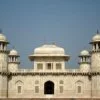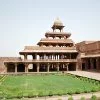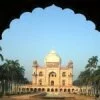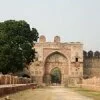 All Entries Tagged With: "Mughal"
All Entries Tagged With: "Mughal"

Akbar’s Tomb
Akbar’s Tomb is located in Sikandra, at the outskirts of the city of Agra in India. Akbar started building the Tomb in his lifetime around 1600. He was laid to rest here after his death in 1605. His son Jahangir completed the construction work between 1605-1613.

I’tmad-ud-Daula’s Tomb
I’tmad-ud-Daula’s Tomb is the tomb of Mirza Ghiyas Beg and his wife Asmat Begum. Mirza Ghiyas Beg came to India from Persia and joined the court of Mughal emperor Akbar. He rose in Akbar’s court and Akbar conferred on him the title I’tmad-ud-Daula, which means, the pillar of the State.
Agra Fort
Agra Fort is close to the Taj Mahal in the city of Agra. It gained importance as Akbar made Agra his capital in 1558 and rebuilt the fort. Agra Fort is well preserved and has beautiful palaces and courts.

Fatehpur Sikri
Fatehpur Sikri is a historic city located about 37 km west of the city of Agra. Akbar made Fatehpur Sikri his capital in the year 1571. Fatehpur Sikri complements Agra with its own share of historical monuments, which are in an excellent state of preservation.

Safdarjung’s Tomb
Safdarjung’s Tomb is the tomb of Mirza Muqim Abul Mansoor Khan (1708-54), who is better known by his title, Safdarjung. Safdarjung, was the powerful governor of the province of Awadh and a key member of cabinet under the Mughal emperor Muhammad Shah and later prime minister under his successor, Ahmad Shah Bahadur.

Abdul Rahim Khan-i-Khana’s Tomb
Mirza Abdul Rahim Khan-i-Khana (1556-1627), popularly known as Rahim, was son of Bairam Khan and was one of the Navaratnas, or main ministers, in the court of the great Mughal emperor, Akbar. Abdul Rahim was a learned man with great command over Arabic, Persian, Turkish, Hindi and Sanskrit languages.

Humayun’s Tomb
Humayun (1508-56) was the second Mughal emperor who ruled during 1530-56. Humayun’s Tomb is a UNESCO World Heritage Site and was built by his widow, Hamida Banu Begum during the years, 1565-72.

Monuments near Old Fort, Delhi
Khair-ul-Manazil is located just opposite to the Old Fort. Lal Darwaza, the Red Gate, is close to the Khair-ul-Manazil.

Red Fort, Delhi
Red Fort was built by the Mughal emperor Shah Jahan during 1639-48. The Mughals used Agra as their capital till the year 1649. Shah Jahan developed the seventh city of Delhi, Shahjahanabad, the present-day Old Delhi and made it his capital in 1649.

